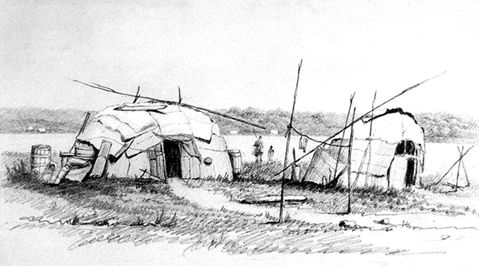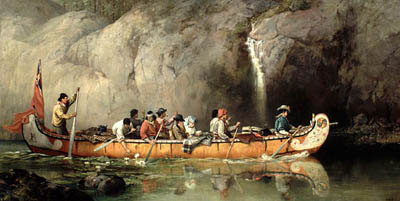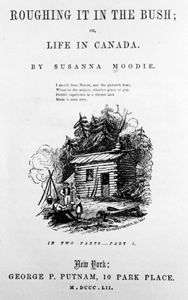Anna Brownell Jameson, née Murphy, author, artist, art historian and feminist (born 19 May 1794 in Dublin, Ireland; died 17 March 1860 in London, United Kingdom). Anna Jameson spent the winter and spring of 1836–37 in Toronto with her husband, Robert Sympson Jameson, attorney general of Upper Canada. She travelled extensively in southern Ontario during the summer of 1837, recording her impressions through her sketches, watercolours and writing in Winter Studies and Summer Rambles in Canada (1838).

Early Life and Education
Anna Brownell Murphy was the eldest of five daughters of miniaturist and portrait painter Denis Brownell Murphy, who became “painter in enamel” to Princess Charlotte, daughter of the Prince and Princess of Wales and heir presumptive to the future King George IV, in 1810. Her mother, Johanna, was English, and the family immigrated from Ireland to England in 1798. Anna was educated by a French-speaking governess, Miss Yokeley, until the age of 12, and then took charge of her own education and that of her younger sisters. She showed an interest in languages, studying French, Italian and Spanish, and wrote poetry from childhood.
In 1810, Anna became governess to the children of the Marquess of Winchester. She spent the next 15 years teaching the children of prominent families, travelling to Italy with the Rowles family in 1821. The death of Princess Charlotte in childbirth in 1817 resulted in a decline in the Murphy family’s fortune, and she turned to writing, in addition to teaching, to help support her unmarried sisters.
Marriage
In 1825, 31-year-old Anna Brownell Murphy married Robert Sympson Jameson — two years her junior — a barrister whom she had met in 1821. Despite their shared literary and artistic interests, their courtship had been a difficult one, and she hesitated to accept his proposal of marriage. In 1822, she wrote to her mother, “I have the firm conviction that there exists a disparity between our minds and characters, which will render it impossible for me to be quite happy with him.”
Writing
In 1826, Anna Brownell Jameson published her first book, Diary of an Ennuyée (first published anonymously as A Lady’s Diary), a novel inspired by her travels in Europe with the Rowles family. She also wrote articles for The London Magazine about her travels. Jameson wrote works of popular history, travel writing and literary criticism for a female audience in the early 1830s. The book that established her reputation as an author and a scholar was Characteristics of Women, Moral, Poetical and Historical (1832), later known as Shakespeare’s Heroines.
Canada
Robert Jameson was appointed attorney general of Upper Canada in 1833, and Anna Brownell Jameson agreed to join him, sailing from London on 8 October 1836 before finally arriving in Toronto in mid-December. She spent the winter and spring of 1836–37 in Toronto with her husband. Her first impression of Toronto on 20 December was “A little ill-built town on low land, at the bottom of a frozen bay, with one very ugly church, without tower or steeple; some government offices, built of staring red brick, in the most tasteless, vulgar style imaginable; three feet of snow all around; and the grey, sullen, wintry lake.” She was unhappy with both the city and her marriage. She wrote to her parents and sisters, telling them that Toronto was “a small community of fourth-rate, half-educated or uneducated people, where local politics of the meanest kind engross the men, and petty gossip and household cares the women.” One of her few friends in Toronto was James FitzGibbon, a veteran of the War of 1812, whom she described as “a soldier of fortune” who “owes nothing whatever to fortune, but everything to his own good heart, his own good sense and his own good sword.”
In June 1837, Jameson left Toronto and travelled around southern Ontario — visiting Niagara-on-the-Lake, Hamilton, London and Port Talbot — and Michigan, taking an open boat to Sault Ste. Marie, Lake Huron and Manitoulin Island. She enjoyed her journey and became the first European woman to “shoot the rapids” in Sault Ste. Marie. In September 1837, Jameson left Upper Canada, returning to the United Kingdom in February 1838 after visiting the United States. She continued to follow events in Upper Canada, writing to her friend Sarah Austin about the Rebellions of 1837–38, which took place just after her departure: “There has been much error and misrule on the part of our Government, and the magnificent capabilities of Canada seem, as yet, little understood.”
Winter Studies and Summer Rambles in Canada
Anna Brownell Jameson’s book about her Canadian experiences, Winter Studies and Summer Rambles in Canada, was published in 1838. The book was a travelogue divided into two sections: her unhappy winter in Toronto, with her critical observations of Upper Canada society, and her summer journey by carriage, steamer and canoe around southern Ontario. It was on her summer adventures that she celebrated the opportunity to travel alone, visit Indigenous communities and experience Canadian landscapes, including “those wild, impatient, tumultuous rapids” at Niagara and the “giddy, breathless, delicious excitement” of shooting the rapids in a canoe at Sault St. Marie. Throughout her account of her “summer rambles,” Jameson compared the role of women in European and Indigenous societies, admiring the independence of Indigenous women.
Separation
The Jamesons signed a separation agreement in 1837 before Anna Brownell Jameson’s departure from Upper Canada. They agreed that they would live apart and Robert Jameson would pay her £300 per year. In a letter to his wife, dated 21 September 1837, he wrote, “In leaving Canada to reside among your friends in England or elsewhere, you carry with you my most perfect respect and esteem. My affection you will never cease to retain. Were it otherwise I should feel less pain at consenting to an arrangement arising from no wish of mine, but which I am compelled to believe is best calculated for your happiness.” This unusually amicable separation allowed her to retain the royalties she received from her writing. Until the Married Women’s Property Act of 1870 was passed, British husbands were entitled to their wife’s earnings. The couple never saw each other again once she returned to Europe, but they corresponded occasionally.

Art
During her travels in Canada, Anna Brownell Jameson created more than 50 drawings, including Winter Journey from Niagara by Lake Ontario and Voyage Down Lake Huron in a Canoe, which are now in the collection of the Royal Ontario Museum. Jameson sketched and painted Indigenous communities and peoples, including Pen Sketch [Intaglio] of an Indian Woman Walking, Wigwams on the Beach at Mackinaw and Island of Mackinaw, Lake Huron and watercolours of “a warrior dancing.” An album of Jameson’s sketches is part of the Special Collections & Rare Books section at Toronto Public Library.
Later Writing and Advocacy
After the publication of Winter Studies and Summer Rambles in Canada (1838), the focus of Anna Brownell Jameson’s writings shifted from travel to art history and criticism. She was one of the first professional female art critics and art historians, and the first professional English art historian. Her multi-volume series Sacred and Legendary Art (published between 1848 and 1864) was the first systematic study of Christian iconography in English.
In her later years, Jameson mentored a younger generation of feminist thinkers, including Emily Faithfull, founder of the English Woman’s Journal, and Barbara Leigh Smith Bodichon, a founder of Girton College, Cambridge. Jameson advocated for greater educational opportunities and legal protections for women. Jameson’s feminist philosophy was informed by her observation of the prominent role of women in Indigenous communities during her time in Canada. She wrote that Indigenous marriages considered the needs of both partners, and Chippewa women were able to be self-sufficient because of their society’s “ideas of individual freedom.” Her last publication was The Communion of Labour: A Second Lecture on the Social Employments of Women in 1856. Jameson died of bronchial pneumonia in 1860.
Canadian Legacy
Anna Brownell Jameson’s Canadian art and writing have received a variety of critical responses. In her own lifetime, Winter Studies and Summer Rambles in Canada received positive reviews and a wide readership. In 1982, Marian Fowler credited Jameson with pioneering a new genre in Canadian literature — “the feminist picaresque” — where a voyage into the wilderness is “a metaphor for a much more daring psychological one into unknown areas beyond sex stereotyping and society’s artificial fences, which keep women dependent, delicate and sexually innocent.” Her work set the scene for the later novels of Constance Beresford-Howe, Ethel Wilson, Margaret Laurence and Joan Barfoot.
In the 19th century, Jameson provided an example for the travels and work of subsequent female artists in Canada, including Frances Anne Hopkins. In his 1967 history of Painting in Canada: A History, however, J. Russell Harper declared that “[Jameson’s] own sketches of Upper Canada demonstrate no particular talent.” Jameson’s art has been re-evaluated in recent years. The Royal Ontario Museum displayed five of Jameson’s sketches, alongside the art of Susanna Moodie, Alice Killaly and Ruth Abernethy, in a 2013 exhibition, Brushing It in the Rough: Women, Art and Nineteenth-Century Canada.

 Share on Facebook
Share on Facebook Share on X
Share on X Share by Email
Share by Email Share on Google Classroom
Share on Google Classroom




